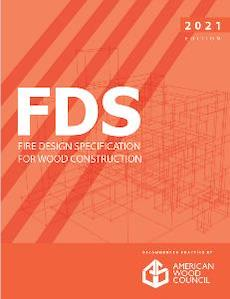AWC Releases New Fire Design Publication
THURSDAY, JUNE 17, 2021
The American Wood Council recently released a new publication for fire design of wood members, assemblies and connections to meet code requirements, 2021 Fire Design Specification for Wood Construction.
“The FDS pulls everything you need to know about fire design of wood members, assemblies and connections into one document,” said AWC Vice President of Engineering Bradford Douglas.

 |
“The most reliable data available from laboratory tests and experience with wood structures in service have been carefully analyzed and evaluated to provide, in convenient form, a comprehensive standard of practice. We invite and welcome comments, inquiries, suggestions, and new data relative to the provisions of this document.”
Since 2001, the National Design Specification for Wood Construction has contained provisions for the structural design of unprotected wood members exposed to a standardized ASTM E119 fire exposure.
The FDS contains these existing provisions and also provides calculation procedures to address the added fire resistance and thermal benefits of protection provided by use of additional wood cover, gypsum panel products and insulation. The additional provisions have been developed to provide standardized methods of calculating thermal separation and burn-through requirements as required in ASTM E119 and as provided in AWC’s Technical Report 10: Calculating the Fire Resistance of Exposed and Protected Wood Members (TR10).
The 2021 Fire Design Specification for Wood Construction is available for free download on the AWC website.
Past AWC Updates
Last August, AWC, along with the International Code Council, released a joint publication: Mass Timber Buildings and the IBC, which aims to provide an overview of requirements for mass timber construction as found in the 2015, 2018 and 2021 International Building Code.
The document highlights changes beginning with the 2015 International Building Code that allow for construction of mass timber buildings with larger heights and areas than was permitted for buildings of wood construction types (Types III, IV and V) prior to the 2015 IBC.
The document also reviews the 2015 IBC recognition of cross-laminated timber, the reorganization of heavy timber provisions in the 2018 IBC, followed by the changes in the 2021 IBC and International Fire Code for tall mass timber construction.
Earlier that summer, the American Wood Council released an updated Technical Report 10 (TR10), Calculating the Fire Resistance of Wood Members and Assemblies.
The revised 2020 guidelines are in accordance with the 2018 National Design Specification for Wood Construction.
Three primary revisions were included in the TR10, which are:
- The expansion of design provisions for calculating the contribution of gypsum board protection in Chapter 4, “Design Procedures for Exposed and Protected Wood Members.” The revised provisions provide information for calculating both the increased structural fire resistance and thermal resistance provided by various types of protection.
- The alculation of thermal separation times were updated in Example 5 (Exposed Cross-Laminated Timber floor design) and Example 6 (Exposed Cross-Laminated Timber wall design) to more closely estimate the benefits of protection.
- Example 8 (Protection of Steel Ledger Connection) and Example 9 (Protection of Beam-Column Connection) were also updated to include information on use of gypsum board as required to protect connections of mass timber members in the new Type IV-A and IV-B buildings permitted in the 2021 International Building Code; and a new Example 10 (Protection of Tension Splice Connection) was added at the request of designers seeking an example of a completely concealed mass timber connection.
Most recently, last month, the AWC completed testing of connections used in cross-laminated timber diaphragm. The latest tests results showed that the connections performed better than expected in higher-than-expected shear capacities.
The tests were conducted in support of new criteria for design of the CLT diaphragm design approach included in the 2021 Special Design Provisions for Wind and Seismic. They focused on the structural performance of the individual connections of the diaphragm, designed in accordance with the National Design Specification for Wood Construction.
The connection testing was conducted at Weyerhaeuser’s ISO 17025 accredited test facility in Federal Way, Washington, and included lateral, withdrawal and bearing strength per standard methods. The 2021 SDPWS is referenced in the 2021 International Building Code.
Tagged categories: American Wood Council (AWC); Color + Design; cross-laminated timber; Fire; Fireproofing; timber; Wood



